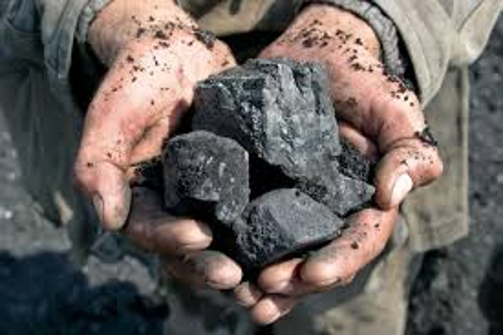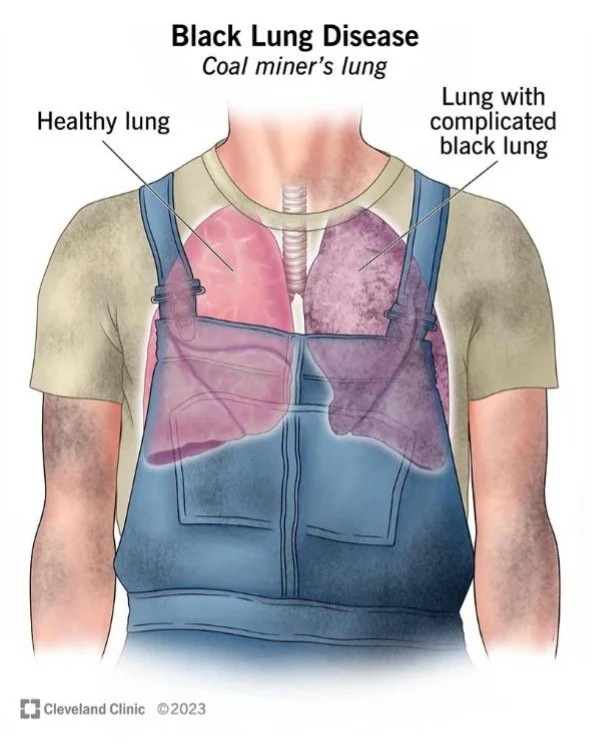What’s Lurking in the Dust? (Black Lung Disease Part 1)
Summary:
Black Lung is back—and hitting younger miners harder and faster. Once thought a relic of the past, this entirely preventable disease is resurging due to unsafe dust exposure and poor risk management. The fix exists. The willpower doesn’t—yet.
What to Know” Guide for Black Lung Disease
Black Lung Disease might sound like the villain in a miner’s nightmare, but for thousands across coal country, it’s a living reality. Officially called Coal Workers’ Pneumoconiosis (CWP), it’s a preventable but incurable lung disease caused by prolonged inhalation of coal dust—a quiet killer that’s staged a troubling comeback in recent decades.¹
What Is Black Lung Disease?¹
Black Lung is a form of pneumoconiosis, a group of occupational lung diseases caused by inhaling harmful dust particles—chiefly coal dust in this case. Over time, inhaled dust settles in the lungs, triggering inflammation, scarring (fibrosis), and permanent lung damage. The name comes from the blackened appearance of lungs observed in autopsies of affected miners.
There are two forms:
Simple CWP – Small spots of scarring; may be asymptomatic early on
Complicated CWP – Large masses of scar tissue; associated with severe breathing difficulty and high risk of death
Prevalence Among U.S. Coal Miners¹²³
Despite improvements in mining safety, Black Lung is back—and spreading fast. After decades of decline, the prevalence has more than doubled since the late 1990s, now affecting nearly 16% of coal workers.² Even more alarming: cases of complicated Black Lung have surged in central Appalachia, where mining through thin coal seams exposes workers to higher levels of silica dust—a more toxic irritant than coal dust, and a known accelerator of lung damage.³
And it’s not just the old guard. Miners in their 30s and 40s are being diagnosed after just 10 to 15 years underground—proof of the intensity of exposure today’s workers face.
How It Shows Up: Symptoms and Impact¹
The symptoms of Black Lung often start quietly—until they don’t. Common complaints include:
Persistent cough
Shortness of breath
Chest tightness
Chronic fatigue
Decreased exercise tolerance
But as the disease progresses, miners can develop chronic bronchitis, heart complications, and even lung cancer. The diagnosis is life-altering. Many are forced to leave the only work they’ve ever known, coping with irreversible damage and lifelong disability.
Prevention Is Possible—But Slipping¹⁴
Here’s the kicker: Black Lung is entirely preventable. Yet enforcement gaps and aging mine infrastructure have left many miners unprotected.
Key prevention strategies include:
Engineering Controls – Improved ventilation, water sprays, and dust collectors
Monitoring – Regular measurement of airborne dust using personal sampling devices
Respiratory Protection – Fit-tested respirators where dust cannot be adequately reduced
Education & Regulation – Miner training and strict compliance audits
The Mine Safety and Health Administration (MSHA) has lowered allowable coal dust limits from 2.0 mg/m³ to 1.5 mg/m³, but compliance remains an uphill battle—especially in mines operating on thin margins.⁴
Managing Black Lung—When Cure Isn’t an Option¹
Once diagnosed, there’s no way to reverse the damage. But symptoms can be managed, and quality of life improved, through:
Oxygen therapy – To improve blood oxygen levels in advanced cases
Pulmonary rehab – Exercise and breathing training to maximize lung capacity
Medications – Including bronchodilators and steroids to ease symptoms
Lung transplant – Considered only in the most severe, end-stage cases
Environmental control – Retiring from mining and avoiding smoke or vaping to slow progression
A Preventable Tragedy—Still Happening
Black Lung should be a thing of the past. Instead, it's a case study in what happens when safety enforcement falters and prevention becomes optional. For miners, early screening and informed advocacy can be lifesaving. For payers and policymakers, it’s a reminder that occupational illnesses don’t vanish—they resurface when vigilance wanes.
By Ema Morse
PharmD Candidate (P4)
For questions, e-mail pharmd@prodigyrx.com
Citations
Black Lung Disease (Coal Workers’ Pneumoconiosis). Cleveland Clinic. Updated July 17, 2023. https://my.clevelandclinic.org/health/diseases/25135-black-lung-disease
Blackley DJ, Halldin CN, Laney AS. Continued increase in prevalence of coal workers’ pneumoconiosis in the United States, 1970–2017. Am J Public Health. 2018;108(9):1220–1222. https://doi.org/10.2105/AJPH.2018.304517
Laney AS, Weissman DN. Respiratory diseases caused by coal mine dust. J Occup Environ Med. 2014;56(Suppl 10):S18–S22. https://doi.org/10.1097/JOM.0000000000000260
Mine Safety and Health Administration (MSHA). Lowering miners’ exposure to respirable coal mine dust, including continuous personal dust monitors. https://www.msha.gov



